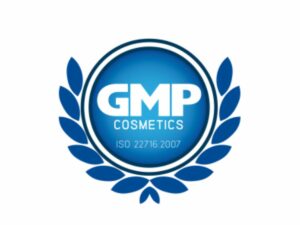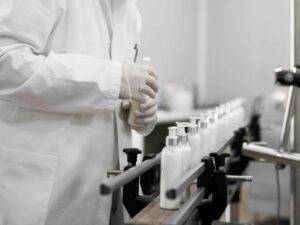Is your skincare brand operating at the peak of quality and safety? Ensuring compliance with robust guidelines can set your business apart in a competitive market.
As a specialist in cosmetic manufacturing processes, my insights are backed by careful research and real-world applications in the industry.
ISO 22716 is the recognized standard for ensuring quality control and safety in cosmetics, enhancing both brand credibility and consumer trust.
In this guide, we’ll delve into the intricacies of ISO 22716, exploring its components and discussing how your business can achieve and benefit from this certification.
Read on to elevate your brand’s commitment to quality and safety.
1. Brief Overview of ISO 22716
Accoridn to LinkedIn, ISO 22716 serves as an international standard for Good Manufacturing Practices (GMP) in the cosmetics industry. It lays out guidelines to ensure the quality, safety, and efficacy of cosmetic products. Developed by the International Organization for Standardization, the certification aims to harmonize varying GMP standards globally.
The standard covers a wide range of areas from raw material selection to product manufacturing and packaging. It also outlines risk management protocols, setting a uniform procedure for complaint handling and product recalls. The goal is to mitigate potential hazards at each stage of production.
For businesses in the cosmetic sector, achieving ISO 22716 certification not only brings operational excellence but also instills consumer trust. It serves as a competitive advantage in a crowded market, demonstrating a brand’s commitment to quality and safety.

2. Importance of ISO 22716 in Cosmetic Industry
This international standard has far-reaching implications that influence the brand’s reputation and market competitiveness. Here’s the breakdown of ISO 22716 importance:
Regulatory Compliance
Compliance with ISO 22716 is often considered a prerequisite for market entry, particularly in regions with stringent regulatory requirements like the European Union. Adherence to this standard simplifies the compliance journey, as it often aligns with regional GMP guidelines. In skincare brands, meeting these criteria can speed up the process of gaining licenses, thus enabling quicker product launches.
Quality Assurance
Quality is a non-negotiable element in the cosmetic industry, and ISO 22716 acts as a quality assurance system. It standardizes various aspects of production, from sourcing of raw materials to manufacturing, packaging, and distribution. By implementing this standard, companies can eliminate inconsistencies, thus enhancing brand credibility and consumer trust.
Risk Management
The proactive approach to risk management that ISO 22716 mandates helps in the identification, assessment, and control of hazards. This includes potential quality deviations, contamination, and other issues that could lead to recalls or damage to the brand’s reputation. The standard’s risk management guidelines enable manufacturers to preemptively address these challenges, ensuring product safety and limiting liability.
Global Harmonization
In an increasingly globalized market, having a universally accepted standard like ISO 22716 can be a game-changer. This helps to level the playing field and harmonize the quality expectations across different markets. It makes partnerships more viable, and simplifies the distribution process. The standard ensures that products meet international expectations, making it easier for brands to penetrate new markets successfully.
Consumer Trust and Brand Equity
In the competitive landscape of the cosmetic industry, trust is invaluable. Consumers are more discerning than ever about the products they choose, often scrutinizing labels and demanding transparency. An ISO 22716 certification acts as a seal of approval, assuring customers of a brand’s commitment to quality and safety. This, in turn, boosts brand equity and can be a critical differentiator in a saturated market.

3. Key Requirements of ISO 22716
Navigating the complexities of ISO 22716 certification can seem daunting without a roadmap. Here, we dissect the key requirements that are essential for compliance:
Well-Trained Personnel
According to Cosmetri, the first pillar of ISO 22716 focuses on the people who make the operation work: the personnel. Every employee should have a solid understanding of their role, responsibilities, and the broader implications of their actions on product quality. For example, an employee responsible for quality control should be proficient in conducting tests, interpreting results, and taking appropriate corrective action.
Training in Good Manufacturing Practices (GMP) should be comprehensive and ongoing to ensure that staff are kept up-to-date with the latest industry standards. This commitment to staff training results in higher operational efficiency, fewer errors, and ultimately, a product that meets quality expectations.

High-Quality Equipment
Your equipment must be meticulously maintained and calibrated to ensure it meets the rigorous standards set by ISO 22716. This involves regular check-ups, timely repairs, and ensuring that all machinery is operating within specified parameters. Failure to meet equipment standards can result in product inconsistencies and may put at risk consumer’s safety.
The condition of the equipment directly impacts the quality of the cosmetic product. For instance, a mixing machine that is not calibrated correctly could result in inconsistent product texture, while a malfunctioning filling machine could lead to inaccurate quantities in packaging.

Stringent Raw Material Quality Control
Quality control starts at the very beginning with your raw materials. The standard dictates that all raw materials must be scrutinized for quality, sourced from reputable suppliers, and stored under appropriate conditions. Inadequate or inferior raw materials can significantly compromise the end product’s quality, and therefore it’s crucial to maintain stringent controls at this stage.
Comprehensive Documentation
Transparent record-keeping is a cornerstone of ISO 22716 compliance. Every aspect of the production process, from raw material sourcing to distribution, must be documented. For example, if a particular batch of product fails quality tests, well-maintained records can help identify at which stage the error occurred, whether during sourcing, manufacturing, or any other phase, enabling quick and effective resolution.

Rigorous Quality Control Procedures
Quality control is the final barrier that ensures only safe and effective products reach the consumer. ISO 22716 stipulates that finished products must undergo rigorous testing before they are released into the market. This includes both in-process and final product inspections to confirm that they meet all predetermined quality specifications.
Any product that fails to meet these standards should be quarantined and subjected to an investigation to determine the next steps, be it rework or disposal. This ensures that subpar products never make it to the market, safeguarding both consumer trust and brand reputation.

4. Steps to Achieve ISO 22716 Certification
The journey to achieving ISO 22716 certification is one that requires meticulous planning, organization, and implementation. Below, we walk you through the key steps to obtaining this valuable certification:
Step#1 Initial Gap Analysis
The first step towards ISO 22716 certification is conducting a gap analysis. This involves an in-depth evaluation of your existing processes and protocols to identify how they measure up against the requirements of the standard. The goal is to pinpoint any areas of non-compliance or inefficiency that need to be addressed.
To conduct this analysis effectively, Nako Cosmetic involves a multidisciplinary team comprising quality assurance experts and other relevant stakeholders. They can evaluate the present state of affairs and recommend necessary changes. After the analysis, a report should be prepared detailing the gaps and the steps needed to close them.
Step#2 Assemble a Dedicated Team and Training
Once you understand where your operations stand in relation to the ISO 22716 standard, the next step is to assemble a dedicated team responsible for driving the certification process. This should include key personnel from various departments like manufacturing, quality assurance, and logistics.
Comprehensive training must be provided to ensure that everyone understands the implications of ISO 22716. Including the changes that will be implemented, and their individual roles in achieving compliance. The training should be ongoing to keep the team updated on any changes or updates to the standard.
Step#3 Implementation of Changes
After the team is trained and ready, you’ll need to start implementing the changes necessary for compliance. This could involve updating or creating new standard operating procedures (SOPs), modifying production workflows, and making infrastructural adjustments.
During this phase, it’s critical to maintain rigorous documentation to provide an audit trail for compliance. Given the complexity of these changes, Nako Cosmetic take a phased approach, periodically reviewing the effectiveness of new processes before fully implementing them.
Step#4 Internal Audits
Before inviting external auditors to evaluate your compliance, it’s prudent to conduct internal audits. This serves as a self-check to ensure that all implemented changes align with ISO 22716 requirements. The internal audit should mimic the procedures that an external audit would involve, from examining documentation to conducting interviews with key personnel.
As from my experience, any discrepancies found should be corrected promptly. This will not only prepare your organization for the actual certification audit but also instill confidence within the team that you are on the right path.
Step#5 External Audit and Evaluation
The penultimate step is the external audit, carried out by a certified body. This involves a thorough review of your operations, documentation, and compliance level. The auditors will provide a detailed report identifying any areas of non-compliance and recommended corrective actions.
It’s important to act swiftly on these recommendations and rectify any identified issues. The audit report will serve as the basis for your certification, so it’s imperative that all concerns are addressed promptly and effectively.
Step#6 Certification and Continuous Improvement
Once you’ve passed the external audit, congratulations are in order—you’ve achieved ISO 22716 certification. However, the journey doesn’t end here, continuous improvement is a key principle of ISO standards. Regular internal audits should be conducted to ensure ongoing compliance, and you should be prepared for periodic external audits for recertification.
Moreover, staying updated on any amendments to the ISO 22716 standard is crucial for maintaining your certification and the benefits it brings to your brand.
5. 5 Tips on How to Maintain ISO 22716 Compliance
Maintaining the ISO 22716 certification is an ongoing effort that requires vigilance, continuous improvement, and periodic review. Here, we offer practical tips on how to uphold the high standards set by ISO 22716:
#1 Regular Training and Skill Development
This involves regular training sessions to keep staff updated on any changes in procedures or the ISO 22716 standard itself. Whether dealing with seasoned employees or new hires, make sure that everyone understands the importance of compliance and maintaining it. Training should cover the technical aspects of the job and the quality management system, stressing the relevance of each in maintaining certification.
#2 Periodic Internal Audits
Internal audits should be part and parcel of your compliance maintenance strategy. This self-assessment mechanism is vital for identifying any areas of potential non-compliance before they escalate into major issues. Such audits can be conducted semi-annually or annually, depending on the size and complexity of your operations.
Make sure to involve key personnel from different departments to get a holistic view. After each audit, analyze the results and implement any corrective actions required to rectify deviations from the standard.
#3 Robust Documentation
Maintaining detailed records is crucial for proving ongoing compliance during external audits. Ensure that your documentation system is rigorous and can capture all necessary details about production processes, quality control measures, and any deviations or incidents.
This includes updating standard operating procedures (SOPs), maintaining logbooks, and keeping records of employee training and certifications. A robust documentation system simplifies the process of preparing for external audits and provides a safety net in case of product recalls or customer complaints.
#4 Supplier and Raw Material Monitoring
Your compliance with ISO 22716 is not just about your internal processes but also extends to your suppliers. Periodically review and audit your suppliers to ensure they also adhere to ISO standards or equivalent quality measures.
This involves examining their certification, conducting quality tests on received materials, and even visiting their facilities if feasible. Keeping a vigilant eye on the quality of raw materials helps to ensure that your end product consistently meets the desired standards.
#5 Stay Updated on Regulatory Changes
Staying updated on any changes to the ISO 22716 standard or related regional and international regulations is crucial. Subscribe to relevant journals, newsletters, and regulatory bulletins that can keep you informed about any amendments. Being proactive in this regard allows you to adjust your internal processes accordingly, ensuring continuous compliance and avoiding the risk of sudden non-conformity.
| Strategy for Staying Updated |
Description |
| Regularly Monitor Regulatory Authorities |
Keep a close watch on regulatory agencies and organizations relevant to cosmetics, such as the FDA (in the US), EU Commission, and industry associations. Subscribe to their newsletters, updates, and announcements to receive the latest regulatory changes. |
| Industry Publications and Journals |
Read industry-specific publications, journals, and magazines that focus on cosmetics and regulatory affairs. These sources often feature articles and insights on evolving compliance requirements. |
| Attend Conferences and Webinars |
Participate in cosmetics industry conferences, seminars, and webinars. These events often include sessions on regulatory updates and compliance best practices. |
| Join Professional Associations |
Become a member of professional associations dedicated to cosmetics and personal care, like the Personal Care Products Council (PCPC). These organizations often provide resources and updates to their members. |
| Collaborate with Regulatory Experts |
Establish relationships with regulatory experts or consultants who specialize in cosmetics compliance. They can provide guidance on interpreting and implementing regulatory changes. |
| Engage in Training and Certification |
Enroll in training courses or certification programs related to cosmetics regulations and ISO 22716 compliance. These programs offer structured learning and updates. |
| Review ISO 22716 Standards Directly |
Periodically review the ISO 22716 standard itself and any amendments or revisions issued by the International Organization for Standardization (ISO). |
| Maintain Documented Procedures |
Ensure that your organization maintains documented procedures for compliance with ISO 22716 and updates them as needed in response to regulatory changes. |
| Internal Audits and Self-Assessment |
Conduct regular internal audits and self-assessment checks to identify gaps in compliance and make necessary adjustments based on updated regulations. |
| Seek Legal Counsel if Necessary |
Consult with legal professionals who specialize in cosmetics regulations and compliance to ensure full adherence to changing laws and standards. |
Dive Deeper Into Our Resources
For some insightful reads, we’ve curated a list of recommended articles just for you:
Still haven’t found what you’re looking for? Don’t hesitate to contact us. We’re available around the clock to assist you.
Conclusion
Achieving and maintaining ISO 22716 compliance is a complex yet rewarding journey that elevates your brand’s reputation and product quality. This guide aims to simplify that path, offering actionable insights and detailed steps to help you navigate the compliance landscape with confidence.
If you’re looking for more expertise in navigating ISO 22716 or other industry-specific challenges, Nako Cosmetic is here to help. For tailored solutions and further guidance, feel free to contact us.





